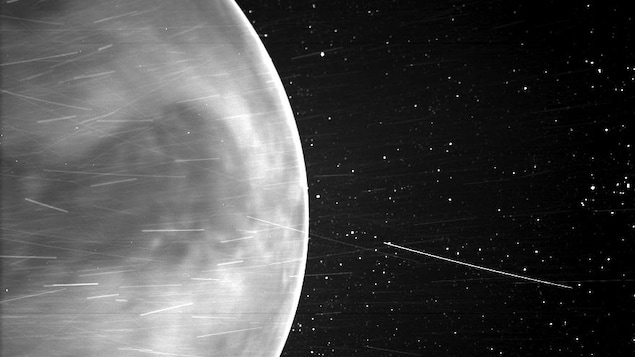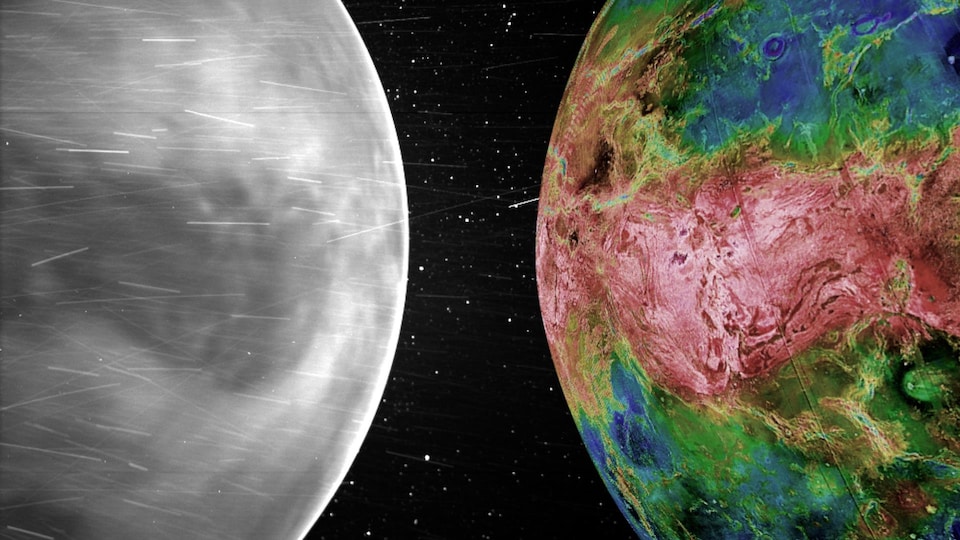The probe captured images of Venus during two flybys of the planet in July 2020 and February 2021. A video of the entire night face of this Earth neighbor was produced from the images.
The main mission of the Parker probe is to study the Sun, but Venus plays an important secondary role there because the planet’s gravity allows the probe to adjust its orbit.
This gravitational enhancement from Venus brings Parker closer and closer to the Sun, giving him the opportunity to study the dynamics of the solar wind near its source.
During its mission, the probe must use the gravity of Venus seven times.
These flybys provide the probe with an unexpected opportunity to take unique pictures of the inner solar system. The images provided by NASA were taken during the third and fourth gravitational assistance to Venus, when the Parker probe was at a distance of 12,380 kilometers from its surface.
The images reveal distinct geological features including continental areas, plains and plateaus.
It is also possible to observe a luminous halo of oxygen in the upper atmosphere of the planet.
Parker continues to exceed our expectations and we are excited that these groundbreaking observations made during the gravity assist maneuver could advance Venus research.
Nicholas Fox of NASA says in a press release.
These new images of Venus could help astronomers not only better describe the geology of Venus’ surface but also learn about the minerals that are there.
Given the similarities between Venus and Earth, this information will help scientists understand why Venus has been inhospitable while Earth has become an oasis.
Mr. Fox adds.
Milestones
- Venus is the size of Earth with 95% of its diameter and 80% of its mass.
- It is the second of the eight planets in the solar system from the sun. It is located between Mercury, which is closest to the Sun, and Earth.
- The direction of its rotation is backwards, unlike that of all other planets. A collision in the early stages of its development may be the cause.
- The existence of bodies of water on Venus has not been confirmed beyond a reasonable doubt.
evening star
Venus is the third brightest celestial body in the sky, but until recently we didn’t have much information about what its surface looked like because the thicker atmosphere obscures our view.
Explains Brian Wood, a physicist at the Naval Research Laboratory in Washington and lead author of the study published in Geophysical Research LettersOwns (A new window)Owns.
” Now we see for the first time the surface from space [de Vénus] at visible wavelengths. »
Clouds block much of the visible light coming from the surface of Venus, but longer visible wavelengths, which limit near-infrared wavelengths, can cross.
During the day, this red light is lost among the sun’s rays reflecting off the cloud tops of Venus, but in the darkness of night, WISPR cameras were able to capture this faint glow caused by the intense heat emitting from Venus. surface.
Even on the night side, it’s so hot that Venus’ rocky surface glows visibly, like a piece of iron from a smelter.
Brian Wood explains.
The main missions of Venus
- In 1961, Venera 1 became the first spacecraft to visit Venus. Unfortunately, contact with this Soviet probe is lost when it is 100,000 km from the planet.
- In 1964, the Soviet Zond 1 probe passed within 100,000 km of Venus but did not send any data.
- In 1965, Venera 3 made the first successful entry into the planet’s atmosphere, but, again, no information was transmitted.
- In 1967, Venera 4 entered the atmosphere of Venus and sent data up to about 25 km from its surface.
- In the same year, the American probe Mariner 5 made a close trip up to 4000 km from the surface.
- In 1970, the Venera 7 probe made its first successful landing.
- Two years later, Venera 8 sends information about the planet’s surface and the composition of its atmosphere.
- In 1975, the Venera 9 probe sent back the first images of the surface.
- Several sensors, including the American Pioneer Venus 1 and 2, are then sent out, and transmit data on their atmosphere.
- In 1982, the Venera 13 probe sent the first color images of the surface and the first analyzes of its landing site.
- Between 1989 and 1994, the American Magellan probe made it possible to map 98% of the surface of Venus. Earth monitors the planet with radar because the clouds prevent it from seeing it. Images are reconstructed from radar data.
- In 2005, the European Space Agency launched the Venus Express probe. This mission, which ended in 2014, made it possible to collect a huge amount of information on the planet.
- In 2010, the Japanese space probe Akatsuki was placed in orbit around Venus, but this orbit was much higher than the target, which did not allow it to achieve all its goals.
- From 2028 to 2030, NASA’s Da Vinci + and Veritas missions will have to measure the composition of their atmosphere and geological history.

“Hardcore beer fanatic. Falls down a lot. Professional coffee fan. Music ninja.”








More Stories
SALES / PHOTO SALES – Nikon D850 “5 Star” Bare Body Photo Body at €2,539.00
Discovering a new turning point under the Antarctic ice sheet! What are the consequences?
Record number for an insect!